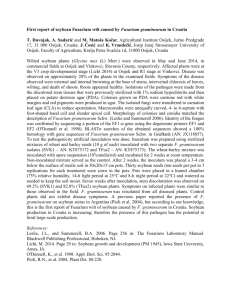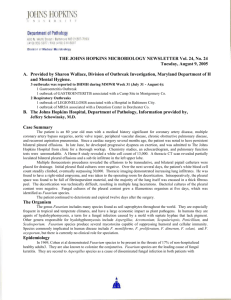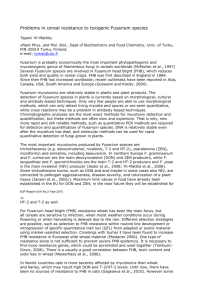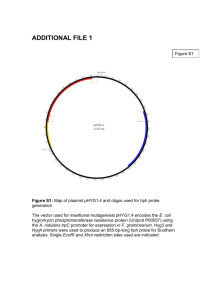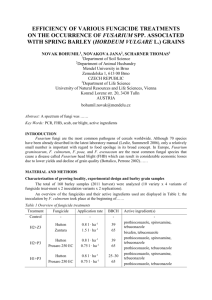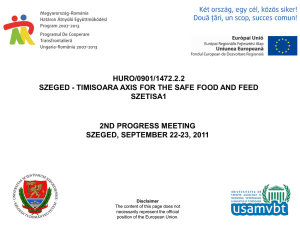Fusarium Test
advertisement
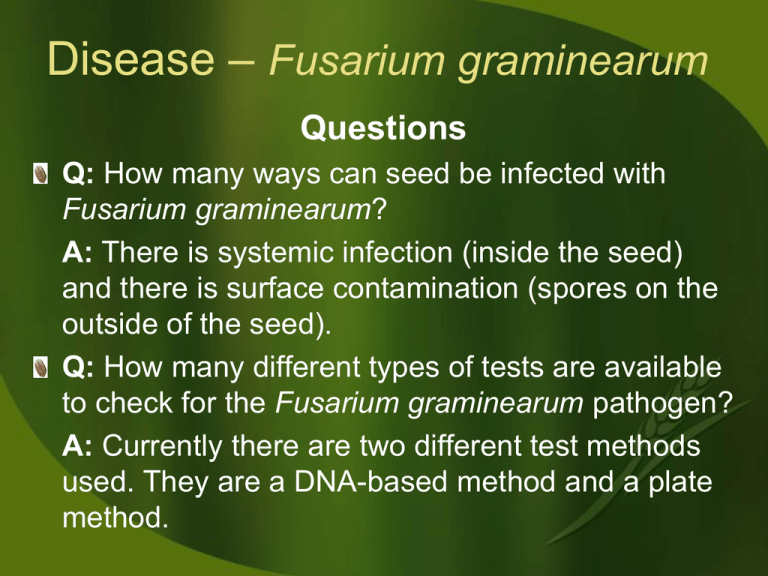
Disease – Fusarium graminearum Questions Q: How many ways can seed be infected with Fusarium graminearum? A: There is systemic infection (inside the seed) and there is surface contamination (spores on the outside of the seed). Q: How many different types of tests are available to check for the Fusarium graminearum pathogen? A: Currently there are two different test methods used. They are a DNA-based method and a plate method. Disease – Fusarium graminearum The two tests differ in many respects: Technology Amount of seed Sensitivity Time Type of result Both tests have a role in providing our customers with accurate and timely results for superior seed quality management Disease – Fusarium graminearum 15 grams (over 400 seeds) Detection level lower than 0.1% 200 seeds Detection level of 0.5% Disease – Fusarium graminearum DNA uses a portion of the seed sample as received (no cleaning or sterilizing) Any Fusarium graminearum spores attached to dirt or dust particles on the outside of the seed are detected Plate uses a portion of the seed sample that’s sterilized with chlorine bleach The bleach kills most organisms (including any Fusarium spp.) that are on the outside of the seed Disease – Fusarium graminearum 1 – 2 days for results 5 – 8 days for results Disease – Fusarium graminearum DNA provides a positive(+) or negative(-) result Plate provides a percent(%) infection result Disease – Fusarium graminearum Our standard method is the DNA-based test It is much more accurate due to the number of seeds, the dual level of detection, and the lower level of detection All positive(+) results from the DNAbased test are plated to determine the percentage(%) of infection Disease – Fusarium graminearum A positive(+) from the DNA-based test and a negative(-) from the plate test means: (1) the infection is below the plate test detectable level of 0.5% or (2) the infection is surface contamination and was killed during sterilization or (3) the spores are not viable or (4) combinations or 1,2, and 3 above Progress and Personnel Most seed labs do not use the DNAbased test, so they are missing many seed samples that are infected with Fusarium graminearum Early identification of low level infected seed can help to reduce the planting of infected seed Fusarium Test Review Timely and efficient 1-2 day turnaround time assists with scheduling and cleaning plant efficiency Accuracy Over 400 seeds tested (>twice the plate test) Detection of spores on the seed surface Lower detection level Testing at 20/20 Seed Labs Benefit from the features of both tests if necessary (there is no charge for the plate test after a positive(+) DNA-based test) Fusarium Economics 1½ bushels of wheat (an acre) has approximately 1.1 million seeds Planting seed with 0.5% Fusarium graminearum infection means you are planting 5,500 infected seeds/acre Fusarium Economics Manitoba producers experience yield losses of over 20% in highly infected fields Maximum of 0.25% FDK (Fusarium Damaged Kernels) in Red Spring and Hard White No.1 wheat by weight Fusarium Economics Fusarium graminearum can create a mycotoxin called deoxynivalenol or DON which compromises the quality of grain used in milling, baking, and pasta making Malt barley has zero tolerance for the mycotoxin DON Fusarium Economics DON becomes concentrated in dried distillers grain which is a by-product of ethanol production Swine - Feeding DON at levels above 1 ppm in the complete feed will result in some degree of feed refusal. Prevention & Control Measures Test your seed Choose high quality, vigourous seed Choose varieties with the best resistance Treat your seed Practice crop rotation with other crops Scout your field for signs of disease Apply foliar fungicides Bury your stubble and chaff Test your grain
